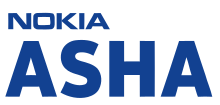Nokia Series 40, often shortened as S40, is a software platform and application user interface (UI) software on Nokia's broad range of mid-tier feature phones, as well as on some of the Vertu line of luxury phones. It was one of the world's most widely used mobile phone platforms and found in hundreds of millions of devices. Nokia announced on 25 January 2012 that the company has sold over 1.5 billion Series 40 devices. It was not used for smartphones, with Nokia turning first to Symbian, then in 2012–2017 to Windows Phone, and most recently Android. However, in 2012 and 2013, several Series 40 phones from the Asha line, such as the 308, 309 and 311, were advertised as "smartphones" although they do not actually support smartphone features like multitasking or a fully fledged HTML browser.

The Nokia 7710 is a mobile phone developed by Nokia and announced on 2 November 2004. It was the first Nokia device with a touchscreen, and first Nokia branded device with 2:1 aspect ratio display. The 7710 is based on the Nokia 7700 which was never released. It is Nokia's only smartphone to run the Series 90 interface atop Symbian OS v7.0s.
The Nokia 6000 series or Classic Business series is range of mobile phones marketed by Nokia. This family of phones is notable for their conservative, unisex designs, making them popular with business users.
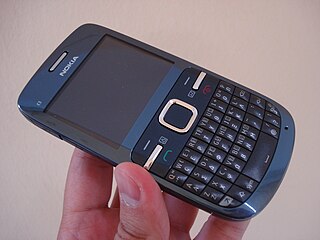
The Nokia C3-00 is a QWERTY keypad feature phone with the Nokia Series 40 mobile operating system, released under the Cseries line of phones by Nokia. It features a full 4-line keyboard, like the earlier Nokia 6800 series. It was advertised as an entry-level messaging and social networking phone, retailing at 90 EUR before taxes. It was introduced on April 13, 2010, alongside the Nokia E5 and C6.
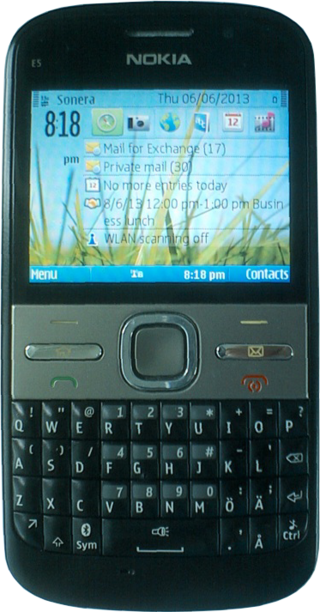
The Nokia E5-00 is a Symbian mobile phone. Like all smartphones in the Nokia Eseries it is targeted at business-to-business and comes with business software applications, including QuickOffice. It was released in the third quarter of 2010. It comes in a candybar form factor with QWERTY keyboard. It is considered a budget smartphone and thus, a successor of the Nokia E63.
Nokia's strategic nomenclature can be traced back in 2005 when the Nseries line was launched, offering devices with flagship specifications and premium hardware at various price points. These devices were considered the "bread and butter" of the company and were often positioned to showcase their latest technologies. Thanks to the newfound consumer and enterprise interest in smartphones at the time, the company introduced four additional collections to diversify their product portfolio and meet demands in most market segments. These new phone series were named Eseries, targeting small business and enterprise customers; Xseries, providing consumer-grade multimedia-focused devices; Cseries, which Nokia used to target both the low-end and mid-range market segments; and Tseries, for devices exclusive to the Chinese market.
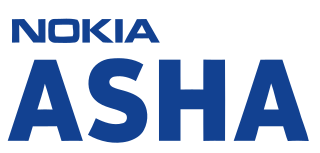
The Nokia Asha 303 is a QWERTY messenger smartphone powered by Nokia's Series 40 operating system. It was announced at Nokia World 2011 in London along with three others Asha phones - the Nokia Asha 200, 201 and 300. The 303 is considered to be the flagship of the Asha family. Its main features are the QWERTY keyboard and capacitive touchscreen, the pentaband 3G radio, SIP VoIP over 3G and Wi-Fi and the ability to play Angry Birds which were all never seen before on a Series 40 phone. Nokia Asha 303 is available in a number of languages depending on which territory it is marketed for. Models sold in South Asia support at least eight languages: English, Hindi, Gujarati, Marathi, Tamil, Kannada, Telugu and Malayalam.
The Nokia 8810 is a discontinued slider-style mobile phone announced and manufactured by Nokia in 1998. It is notable for being among the first mainstream mobile devices to have an internal antenna, although the first is regarded as the TCP-6000, released as the Hagenuk GlobalHandy.

The Nokia Asha 302 is a QWERTY messenger feature phone powered by Nokia's Series 40 operating system. It was announced at Mobile World Congress 2012 in Barcelona along with other Asha phones - the Nokia Asha 202 and 203. The 302 is considered to be among the flagship of the Asha family. Its main features are the QWERTY keyboard, the pentaband 3G radio, SIP VoIP over 3G and Wi-Fi. Its design looks a lot like the older Nokia E6 with chrome slidings, giving it a somewhat premium look. A software update adds Mail for Exchange support.

The Nokia Asha 306 is a "Full Touch" phone powered by Nokia's Series 40 operating system. It was announced at Bangkok by Nokia along with two others Asha Full Touch phones - the Nokia Asha 305 and 311. The 306 is considered to be the little brother of Asha 311 as it lacks 3G and capacitive touch screen. Its main features are the Full Touch resistive touchscreen and WLAN.

The Nokia Asha 305 is a "Full Touch" phone powered by Nokia's Series 40 operating system. It was announced at Bangkok by Nokia along with two other Asha Full Touch phones - the Nokia Asha 306 and 311. Its main features are the Full Touch resistive touchscreen and dual SIM.
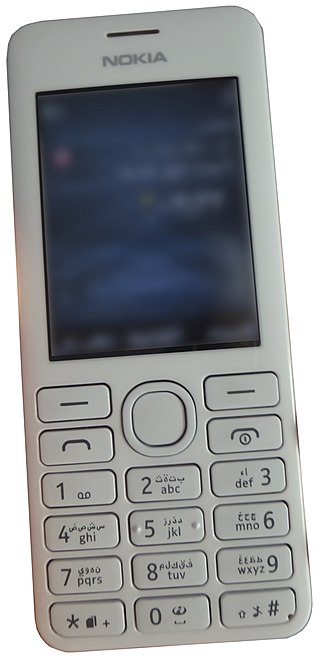
Nokia 206 is an entry level dual-SIM mobile phone from Nokia. It was announced alongside the Nokia Asha 205 in November 2012 and was first released in January 2013. It is the successor to the Nokia Asha 200 and Nokia Asha 201. However, the 206 is not an Asha device.

Nokia Asha 501 is a low-end smartphone from the Nokia Asha series, announced by Nokia on 9 May 2013 in India, and released on 24 June 2013. The device is classified by Nokia as a "Full Touch" smartphone. The phone is available in either single- or dual SIM configuration.

The Nokia X family was a range of budget smartphones that was produced and marketed by Microsoft Mobile, originally introduced in February 2014 by Nokia. The smartphones run on the Nokia X platform, a Linux-based operating system which was a fork of Android. Nokia X is also known generally as the Nokia Normandy. It is regarded as Nokia's first Android device during the company's Microsoft partnership and was in the process of selling its mobile phone business to Microsoft, which eventually happened two months later.

The Nokia Asha 310, also known as the Nokia Asha 3010 or the Nokia ASHA 310 RM-911, was released in March 2013. It is the first in the line of the Asha range of phones to have dual subscriber identity module (SIM) slots and Wi-Fi connectivity. It was a reinvention of the Asha range to remain competitive with new Android devices. It cost $102.00 at its launch date. It has a touchscreen, comes with either a 2 or 4 GB micro SD card, and has 64 MB of RAM, a 2 MP camera and a battery that can last up to 600 hours in standby mode. The phone can play music for up to 54 hours or video for up to 9.5 hours, and has a maximum of 17 hours talk time (2G).
Nokia X2-05 is an entry-level mobile phone running on the Nokia Series 40 operating system. It was announced on October 11, 2011 and was released two months later. The phone was available in Black, Silver, White and Bright Red, and came with a stereo headset and a MicroUSB cable. The suggested price was €46 before taxes and excluding subsidies (SIM-free).

Nokia C1-02 is a basic phone running on Nokia OS Series 40, announced in June 2010 and released in January 2011. It supports two battery types, Nokia BL-5C and BL-5CB. It has an internal memory of 10MB and RAM of 16MB. The expandable memory of the device is up to 32GB. It is available in 4 colours namely - Black, Dark Plum, Blue and Cool Grey. Its cost in July 2015 was around Rs. 2169 in India. Outside India it was sold at $19.99 approx.

Nokia 150 and Nokia 150 Dual SIM are Nokia-branded entry-level mobile phones from HMD Global. Originally introduced in December 2016, as the first Nokia-branded devices by HMD Global, the 150 supports one Mini-SIM card and 150 Dual Sim supports two Mini-SIM cards.

The Nokia 3310 (2017) is a Nokia-branded feature phone developed by HMD Global. It was announced on 26 February 2017 at Mobile World Congress (MWC) 2017 as a revival of the original Nokia 3310 that was produced from the early 2000s. An improved model with 3G support was released on 29 October 2017.
